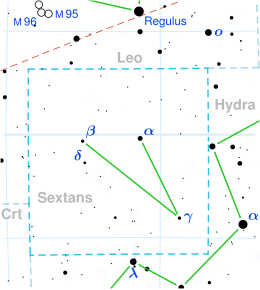Alpha Sextantis
| Observation data Epoch J2000.0 Equinox J2000.0 (ICRS) | |
|---|---|
| Constellation | Sextans |
| Right ascension | 10h 07m 56.29556s[1] |
| Declination | −0° 22′ 17.8621″[1] |
| Apparent magnitude (V) | 4.49[2] |
| Characteristics | |
| Spectral type | A0 III[3] |
| U−B color index | −0.07[2] |
| B−V color index | −0.04[2] |
| Astrometry | |
| Radial velocity (Rv) | 10.00[4] km/s |
| Proper motion (μ) | RA: −25.83[1] mas/yr Dec.: −4.25[1] mas/yr |
| Parallax (π) | 11.51 ± 0.98 mas[1] |
| Distance | 280 ± 20 ly (87 ± 7 pc) |
| Absolute magnitude (MV) | −0.29±0.21[5] |
| Details | |
| Mass | 2.57±0.32[6] M☉ |
| Radius | 3.07[6] R☉ |
| Luminosity | 90[6] L☉ |
| Surface gravity (log g) | 3.55[7] cgs |
| Temperature | 9,984[8] K |
| Metallicity [Fe/H] | −0.03±0.18[7] dex |
| Rotational velocity (v sin i) | 21[9] km/s |
| Age | 385[6] Myr |
| Other designations | |
| Database references | |
| SIMBAD | data |
Alpha Sextantis (α Sex, α Sextantis) is the brightest star in the equatorial constellation of Sextans.[11] It is visible to the naked eye on a dark night with an apparent visual magnitude of 4.49.[2] The distance to this star, as determined from parallax measurements,[1] is around 280 light years. This is considered an informal "equator star", as it lies less than a quarter of a degree south of the celestial equator. In 1900, it was 7 minutes of arc north of the equator. As a result of a shift in the Earth's axial tilt, it crossed over to the southern hemisphere in December 1923.[12]
The variability of Alpha Sextantis was discovered by Aven Magded Hamadamen and included in the International Variable Star Index.[13] The star undergoes pulsations with a period of 9.1 hours.[6]
This is an evolved A-type giant star with a stellar classification of A0 III.[3] It has around 2.5[6] times the mass of the Sun and three[6] times the Sun's radius. The abundance of elements is similar to that in the Sun.[7] It radiates 90 times the solar luminosity[6] from its outer atmosphere at an effective temperature of 9,984 K.[8] Alpha Sextantis is nearing the end of its life as a main-sequence star; it is around 385[6] million years old with a projected rotational velocity of 21 km/s.[9]
References[edit]
- ^ a b c d e f van Leeuwen, F. (2007), "Validation of the new Hipparcos reduction", Astronomy and Astrophysics, 474 (2): 653–664, arXiv:0708.1752, Bibcode:2007A&A...474..653V, doi:10.1051/0004-6361:20078357, S2CID 18759600.
- ^ a b c d Mermilliod, J.-C. (1986), "Compilation of Eggen's UBV data, transformed to UBV (unpublished)", Catalogue of Eggen's UBV Data, SIMBAD, Bibcode:1986EgUBV........0M.
- ^ a b Cowley, A.; et al. (April 1969), "A study of the bright A stars. I. A catalogue of spectral classifications", Astronomical Journal, 74: 375–406, Bibcode:1969AJ.....74..375C, doi:10.1086/110819.
- ^ Gontcharov, G. A. (November 2006). "Pulkovo Compilation of Radial Velocities for 35,495 Hipparcos stars in a common system". Astronomy Letters. 32 (11): 759–771. arXiv:1606.08053. Bibcode:2006AstL...32..759G. doi:10.1134/S1063773706110065. S2CID 119231169.
- ^ Gerbaldi, M.; et al. (June 1999), "Search for reference A0 dwarf stars: Masses and luminosities revisited with HIPPARCOS parallaxes", Astronomy and Astrophysics Supplement, 137 (2): 273–292, Bibcode:1999A&AS..137..273G, doi:10.1051/aas:1999248.
- ^ a b c d e f g h i Monier, Richard; Bowman, Dominic M.; Lebreton, Yveline; Deal, Morgan (2023). "The Unexpected Optical and Ultraviolet Variability of the Standard Star α Sex (HD 87887)". The Astronomical Journal. 166 (2): 73. arXiv:2306.08551. Bibcode:2023AJ....166...73M. doi:10.3847/1538-3881/acdee4.
- ^ a b c Pintado, O. I.; Adelman, S. J. (August 2003), "Elemental abundance analyses with the EBASIM spectrograph of the 2.1-m CASLEO Observatory Telescope. I. The late B and early A stars vec xi Octantis, alpha Sextantis, and 68 Tauri", Astronomy and Astrophysics, 406 (3): 987–994, Bibcode:2003A&A...406..987P, doi:10.1051/0004-6361:20030813.
- ^ a b McDonald, I.; et al. (2012), "Fundamental Parameters and Infrared Excesses of Hipparcos Stars", Monthly Notices of the Royal Astronomical Society, 427 (1): 343–57, arXiv:1208.2037, Bibcode:2012MNRAS.427..343M, doi:10.1111/j.1365-2966.2012.21873.x, S2CID 118665352.
- ^ a b Royer, F.; et al. (October 2002), "Rotational velocities of A-type stars in the northern hemisphere. II. Measurement of v sin i", Astronomy and Astrophysics, 393: 897–911, arXiv:astro-ph/0205255, Bibcode:2002A&A...393..897R, doi:10.1051/0004-6361:20020943, S2CID 14070763.
- ^ "alf Sex". SIMBAD. Centre de données astronomiques de Strasbourg. Retrieved 2016-12-12.
{{cite web}}: CS1 maint: postscript (link) - ^ "Sextans (abbr. Sex, gen. Sextantis)", The Internet Encyclopedia of Science, retrieved 2016-12-12.
- ^ Kaler, James B., "Alpha Sextantis", Stars, University of Illinois, retrieved 2016-12-12.
- ^ "VSX : Detail for alf Sex". www.aavso.org. Retrieved 2023-12-02.

